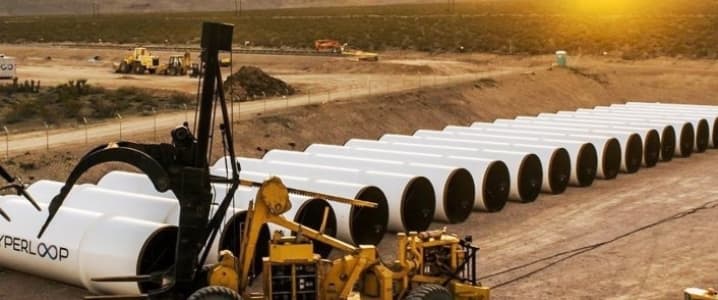Elon Musk’s orphaned hyperloop project may soon be Asia’s next transportation superstar, but competitive prices from fossil fuel-heavy options could derail the new technology’s business model.
CEO Dirk Ahlborn of Hyperloop Transportation Technologies (HTT) says he sees a working hyperloop, which would propel passengers across vast distances in pods at speeds of up to 750 miles per hour, within the next three or four years. Introducing the magnetic transit technology, which was first described by Musk conceptually, but released to be developed by competing agents in the private sector, is now the subject of a feasibility study in South Korea. The study stems from a licensing agreement between HTT and the government for a 200-mile hyperloop between Seoul and Busan.
“The biggest hurdle is to get government approval, so we have been working with governments around the world to advance the legislative framework,” Ahlborn told CNBC last week.
India could be the pods’ next manufacturing site, if ongoing negotiations prove fruitful. But Indian engineers aren’t just taking a backseat in masterminding the new travel category. Based in Bengaluru, Hyperloop India is designing an OrcaPod for the SpaceX Hyperloop Pod Competition in California this year.
Related: Oil Rises, But Saudis Face Daunting Dilemma
To governments in developing countries, the economics of public transport systems create a systemic capital loss, which should encourage countries to adopt public-private partnerships to fund the infrastructure instead, the CEO added.
“If you look at public transportation itself, it’s not really working the way it should; it’s not making money,” he said. “It depends heavily on government subsidies. Taxpayers are paying for it. It doesn’t make business sense.”
The costs of constructing and managing the hyperloop would be shared with a private partner—that is, if feasibility tests administered by HTT and/or its competitors confirm a technical future for the futuristic pod-based travel.
Hyperloop One, another company racing to create Musk’s dream, achieved a small, but important milestone this month. It hit a speed record of 192 miles per hour for 1,433 feet, proving that “Hyperloop is real,” according to a press statement.
The speed is a far cry from the 750-mph target envisioned by Musk. The Shanghai Maglev, the fastest high-speed train in the world, only hits 374 mph at its quickest, meaning the hyperloop tests have failed to demonstrate speeds that would seriously compete with existing and proven options.
Part of hyperloop’s original appeal was its promise to transport groups of three to four humans in chic car-sized pods. Hyperloop One and HTT promise no such luxurious pods. Instead, the projects’ concept art, as well as the size of test tunnels, show the developers preparing for a bus load of passengers to travel within a single mega-pod. This isn’t altogether a bad idea. Trains, trams, and buses have accustomed the public to gathering in small spaces with strangers who they may not have anything in common with, other than their initial or final destinations.
In Asia, poverty bars large swaths of the population from owning cars, paving the way for taxis, trains, and trams to profit from the high transportation demand. The introduction of a hyperloop system in major Asian countries would eat into the government’s earnings from long distance public transit, depending on how affordable the service becomes.
Air travel costs have fallen significantly over the past 20 years, according to the U.S. Department of Transportation. But a 750-mph hyperloop would be faster than an airplane and more environmentally friendly due to its low fossil fuel demand.
Related: Daily OPEC Oil Prices Now Public For The First Time Ever
Marketed as a luxury commute option, the hyperloop would compete with cars or high-end tiers of train transport for cross-country travel. This is especially true for widespread nations such as India and China, which frequently require multi-day journeys to traverse.
Not all work can be completed remotely, and while the internet successfully connects the intellect of people in a virtual world, bringing citizens of the most populous continent in the world together—physically—is the next step in this evolution. It remains to be seen whether the super-speed tubes can be offered to Asian consumers at doable non-dollar rates.
By Zainab Calcuttawala for Oilprice.com
More Top Reads From Oilprice.com:
- Oil Rises To 8-Week High Following Unexpected U.S. Inventory Draw
- Can Oil Ease South China Sea Tensions?
- U.S. Sanctions On Venezuela Could Boost Gasoline Prices


















